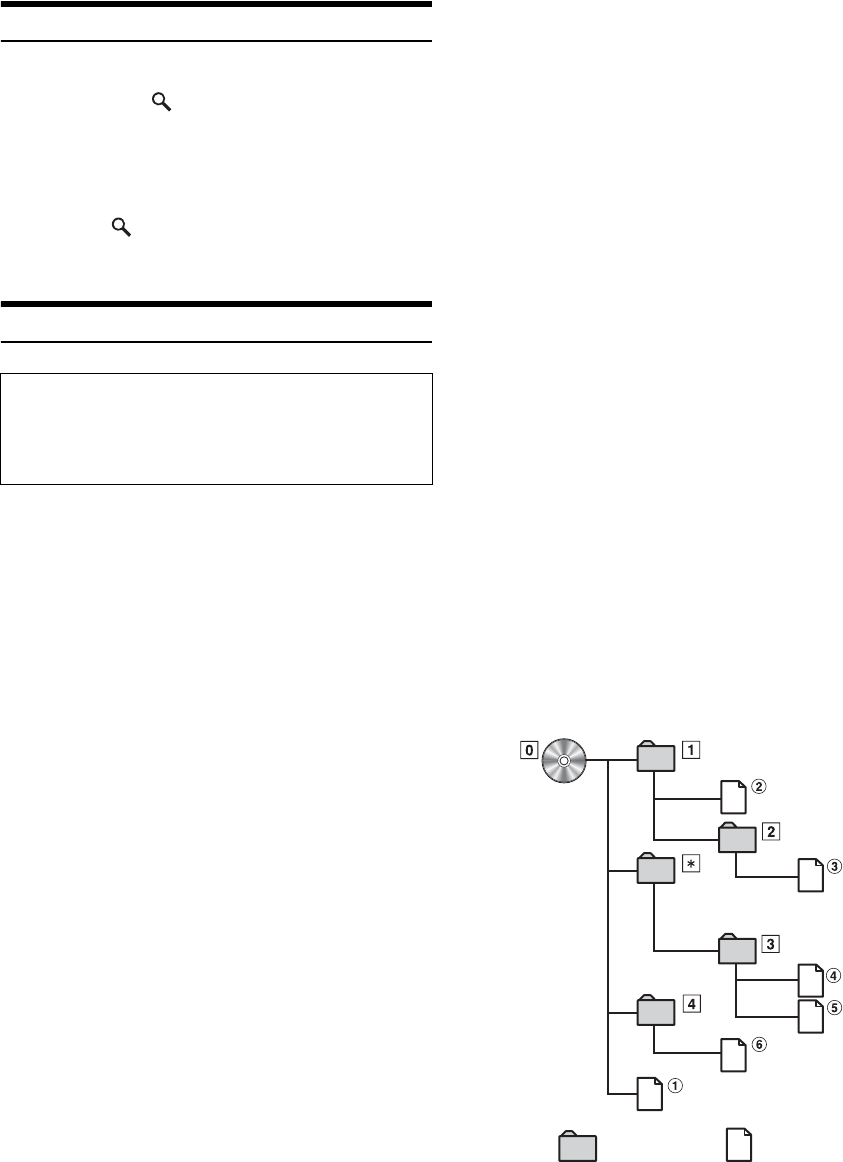
12-EN
Quick Search (CDE-9874 Series only)
You can search for tracks (files).
1
Press and hold /ESC for at least 2 seconds in the
CD/MP3 mode to activate Quick Search mode.
2
Turn the Rotary encoder to select a desired track
(file).
The selected track is played back immediately.
• Press and hold /ESC for at least 2 seconds in the search mode to
cancel. Or, the search mode is cancelled if no operation is performed
for 10 seconds.
About MP3
What is MP3?
MP3, whose official name is “MPEG-1 Audio Layer 3,” is a
compression standard prescribed by the ISO, the International
Standardization Organization and MPEG which is a joint activity
institution of the IEC.
MP3 files contain compressed audio data. MP3 encoding is
capable of compressing audio data at extremely high ratios,
reducing the size of music files to as much as one-tenth their
original size. This is achieved while still maintaining near CD
quality. The MP3 format realises such high compression ratios
by eliminating the sounds that are either inaudible to the human
ear or masked by other sounds.
Method for creating MP3 files
Audio data is compressed using software with MP3 codecs. For
details on creating MP3 files, refer to the user’s manual for that
software.
MP3 files that are playable on this device have the file
extensions “mp3”. Files with no extension cannot be played
back.
Supported playback sampling rates and bit rates
MP3
This device may not play back correctly depending on sampling
rates.
ID3 tags
This device supports ID3 tag v1 and v2.
If tag data is in an MP3 file, this device can display the title
(track title), artist name, and album name ID3 tag data.
This device can only display single-byte alphanumeric
characters (up to 30 for ID3 tags) and the underscore. For non-
supported characters, “NO SUPPORT” is displayed.
The tag information may not be correctly displayed, depending
on the contents.
Producing MP3 discs
MP3 files are prepared, then written to a CD-R or CD-RW using
CD-R writing software. A disc can hold up to 510 files/folders
(including Root Folders), and the maximum number of folders is
255.
Playback may not be performed if a disc exceeds the limitations
described above.
Media supported
The media that this device can play back are CD-ROMs, CD-Rs,
and CD-RWs.
Corresponding File Systems
This device supports discs formatted with ISO9660 Level 1 or
Level 2.
This device also can play back discs in Joliet, Romeo, etc., and
other standards that conform to ISO9660. However, sometimes
the file names, folder names, etc., are not displayed correctly.
Formats supported
This device supports CD-ROM XA, Mixed Mode CD, Enhanced
CD (CD-Extra) and Multi-Session.
This device cannot correctly play back discs recorded with
Track At Once or packet writing.
Order of files
Files are played back in the order that the writing software writes
them to the disc. Therefore, the playback order may not be what
is expected. Verify the writing order in the software’s
documentation. The playback order of the folders and files is as
follows.
* The folder No./ folder Name will not be displayed if no file is
contained in the folder.
CAUTION
Except for private use, duplicating audio data (including MP3
data) or distributing, transferring, or copying it, whether for free
or for a fee, without permission of the copyright holder is strictly
prohibited by the Copyright Act and by international treaty.
Sampling rates: 48 kHz, 44.1 kHz, 32 kHz, 24 kHz, 22.05 kHz,
16 kHz, 12 kHz, 11.025 kHz, 8 kHz
Bit rates: 8 - 320 kbps
Under the ISO9660 standard, there are some restrictions to
remember.
The maximum nested folder depth is 8 (including the root
directory). The number of characters for a folder/file name is
limited.
Valid characters for folder/file names are letters A-Z (all caps),
numbers 0-9, and ‘_’ (underscore).
Root folder
Folder MP3 File


















